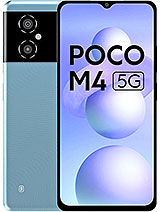Poco C65/Redmi 13C 4G review

MIUI 14 for Poco on top of Android 13
When writing this review, our Poco C65 unit runs Android 13 with MIUI for Poco 14.0.3. This is definitely a very current software combo. Though, we aren't sure what the future holds for Poco devices in relation to Xiaomi's new HyperOS. There's not a lot of difference between the standard MIUI and the iteration for Poco, so we suggest taking a closer look at our MIUI 14 walkthrough. You will find all the information needed there.

The only immediate difference between the standard MIUI and the Poco variety is in the default icon style. It looks as if it's more in line with the stock circular Android icons.
MIUI for Poco also allows you to lock the screen with a double tap on a blank space on the Home screen, while the regular MIUI doesn't. It also lacks the "large icons" feature for what it's worth. We are still unsure how Xiaomi decides which features go in the global MIUI ROM, which ones remain exclusive to the Chinese version and what Poco gets in the end. It's all really convoluted.

Supposedly, MIUI 14 is built almost from scratch as engineers have reworked the core architecture of the MIUI ROM down to Android's Kernel level. That includes new CPU, GPU, and memory scheduling, smaller firmware size, and decreased memory usage overall. As a result, Xiaomi claims a 60% smoother experience and considerably optimized processes. Automatic compression for not actively used apps is also on the menu. Unfortunately, though, those are features that we can reliably test.
The split between the notification shade and Control Center wasn't enabled by default on our review unit, which is odd. We got the standard mixed notification shade and quick toggles menu by default.


Notification shade and quick toggles
The home screen, recent apps and general settings remain unchanged. The app drawer is also enabled by default and cannot be disabled on Poco phones. We like the search bar at the bottom of the screen for easier reach. There are custom and preset app categories for faster navigation.








Home screen, recent apps, settings menu, app drawer
MIUI's recent apps list comes with some useful shortcuts. You can also choose whether you want a vertical or horizontal list of apps. Interestingly enough, bot the Sidebar and the Floating windows functionality as a whole appear to be absent from the Poco C65.
Themes have always been a huge part of MIUI, and they are available on MIUI 14, too. You can download new ones from the Themes store, and they can change wallpapers, ringtones, system icons, and even fonts.






Themes and other customization options
Moving on to privacy and security, MIUI has come with a pre-installed system Security app. Aside from the additional malware protection layer it provides, the app holds many of the app settings and privacy features in one place. It can manage your blacklist, manage or restrict your data usage, configure battery behavior, and free up some RAM. It can also manage the permissions of your installed apps, define the battery behavior of selected apps, and apply restrictions only to certain apps.
All in all, MIUI 14 has changed little over the 13th iteration in terms of overall user experience, and that's not bad. It's just as colorful and customizable as ever.
Performance and benchmarks
Like the Poco C55, the new Poco C65 is based on the MediaTek Helio G85 chipset. It is a pretty old 12nm chip from 2020 that was not particularly well performing back when it came out, and today, it is starting to show its age. There is no point beating about the bush. The performance it offers is disappointing all around.

In the CPU department, the Helio G85 has two big Cortex-A75 cores working at up to 2.0 GHz and another six small Cortex-A55 cores clocked at up to 1.8 GHz. In terms of GPU, the Helio G85 only has a two-core Mali-G52 MC2 to work with. Really, there's not a lot of power to go around. The Helio G85 is paired with LPDDR4X RAM clocked at 1800 MHz.
The Poco C65, in particular, comes in either 128GB/6GB trim or 256GB/8GB, which is the unit we have for review.
Compared to the C55, which starts at 64GB of storage and 4GB of RAM, this is a nice little upgrade, so we can't complain too much. Though, it is worth noting that the Poco C65 uses the slow eMMC kind of storage which could explain its sluggish operation.
Let's kick things off with GeekBench and some CPU runs. It's easy to see that the Helio G85 is not a particularly powerful chip. Granted, once again, we have to remind ourselves of the incredible budget price point of the Poco C65. Even so, however, the amount of available performance is kind of disappointing.
Even the Snapdragon 685 inside the Xiaomi Redmi Note 12 4G seems to offer a bit more performance than the Helio G85 inside the Poco C65. It is also worth noting that the older Redmi Note 8 2021 seems to score a bit better in GeekBench with the same Helio G85 chipset. Not by a lot, mind you, but it is still worth pointing out.
AnTuTu is a bit more favorable to the Poco C65 in this comparison against the older Redmi Note 8 2021. Even so, the overall AnTuTu score is not impressive in any way.
Our Poco C65 review unit stubbornly refused to connect to GFXBench servers and run the benchmark. It did, at least, run 3Dmark after some fiddling. As expected, the Mali-G52 MC2 GPU is pretty underpowered. At least it doesn't have to work too hard pushing pixels to the HD+ resolution display of the C65.
Unfortunately, the Poco C65 doesn't merely look bad in performance benchmarks. Even in practical terms, the phone is pretty slow and laggy. There are noticeable stutters all throughout the UI, even while simply scrolling. The lack of smooth performance is one of the biggest letdowns with the Poco C65.
On a more positive note, at least the C65 does not heat up excessively. Its surface never gets uncomfortable to the touch, even with prolonged stress testing. And the Helio G85 chipset does not get too toasty on the inside, either. It loses some performance with torture testing, but quite a reasonable amount.
Reader comments
- Kayode
- 17 May 2024
- xtS
It doesn't
- Anonymous
- 02 Apr 2024
- 0U3
some people can get their phones to survive more than a few months (like my mother) so i buy her cheap phones and pray hard, it is ok to have some cheap phones in the market until some people learn to be responsible (generally kids)


















